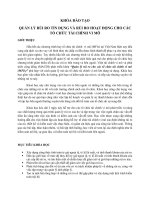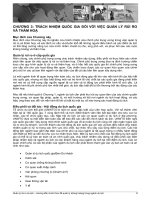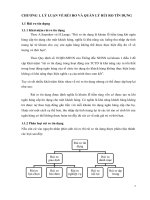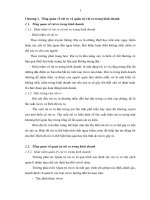Quản lý rủi ro về giá trong ngành công nghiệp năng lượng
Bạn đang xem bản rút gọn của tài liệu. Xem và tải ngay bản đầy đủ của tài liệu tại đây (94.27 KB, 10 trang )
Price Risk Management in the Energy Industry: The Value at Risk
Approach
Alessandro Mauro,
Paper presented to the XXII Annual International Conference of the International
Association for Energy Economics, 9-12 June 1999, Rome
1. Introduction
It is well known that major breakthroughs in oil supply, starting from
the 70s, have led to a considerable amount of volatility in oil prices.
Nowadays other sectors of the energy industry are undergoing major
structural changes. The result on prices will probably be similar, giving
place to a new competitive environment. A primary step for market actors
will be the measurement of new price risk exposure. A modern way to
consider this issue is the Value at Risk (VaR) approach.
The utilisation of a VaR framework to assess price risk is widely
diffused in financial institutions, where profits and losses are calculated
daily (“marking-to-market”). VaR is not widespread in non-financial firms,
because they do not frequently perform marking-to-market on their assets.
Regardless, VaR seems appropriate for industrial firms whose revenues and
monetary costs usually fluctuate due to volatility in prices, particularly in a
short time horizon.
In this paper we show how VaR can be used to measure price risk
exposure in the energy sector. We start by introducing some principal
theoretical facts about VaR, utilising it to calculate risk exposure in the
refining industry. We then investigate the conditions that imply price risk
arising in the energy sector. That enables us to understand where, in the near
future, actors will need price risk management using VaR. A further analysis
of the gas sector demonstrates that also in a bundled supply chain there is
already a certain amount of price risk, due to the formula prices used.
Liberalisation could introduce different scenarios regarding the amount of
volatility in prices, and this point is analysed for power generation, where
interfuel competition will be crucial. Finally we extend the VaR concept to
old and new supply of energy sources; producers, following either a passive
or an active supply strategy, will soon need risk measurement tools.
2. Value at Risk: a theoretical framework
Value at Risk represents the maximum expected loss in the value of an
activity due to an adverse movement in price. The VaR is calculated with
reference to a statistical confidence level and a holding period. The simplest
way to obtain a VaR measure is to suppose that return of the activity is
normally distributed (“parametric approach”). In this case the daily VaR is
VaR = α c Xσ R
α
[1]
is a known function of the confidence level; X is the market value
position at the time of calculation, that is quantity per price; σ R is the daily
standard deviation of the return of the activity and it is the only parameter
that must be estimated in some way. One can expect that under normal
market conditions, in the c% of the total cases, the maximum loss in the
value of the activity will not exceed the VaR figure. A VaR calculation for a
portfolio of activities can also be easily performed; assuming that returns of
all the activities are normally distributed, the VaR is [Dowd (1998)]
C
VaR =
n
n
i =1
j =1
∑ ∑ ρ VaR VaR
ij
i
j
[2]
where ρ ij is the correlation coefficient between returns on activity i and
activity j, and the individual VaR are calculated using [1]. The role of
correlations is crucial. If ρ ij = 1, prices of two activities always move
together; in this case, total VaR is simply (VaR1 + VaR2 ) . This is not a good
situation from the point of view of price risk management, because risks are
additive. Instead, if ρ ij < 1 , VaR < (VaR1 + VaR2 ) , showing that there is a
diversification benefit when activities are not perfectly correlated1.
Both [1] and [2] demonstrate the principal advantage of VaR
utilisation. It summarises in a single measure the price risk associated with
many activities and many business units composing a company. VaR is easy
to understand and communicate, also outside the company. With VaR one
can easily assess the impact of new regulation, as we will show in this paper.
However, we must note that VaR has some limitations, the most important
being the assumptions that must be made about price behaviour of the
activities composing the portfolio.
3. VaR for price risk management in refining
The refining industry is one of the most clear examples of a nonfinancial sector widely exposed to price risk, where VaR can be successful
implemented. We therefore introduce VaR using well known cases taken
from this industry.
As a first example, let us consider crude Brent, contracted in a
competitive market and whose price fluctuates every day. VaR figures are
reported in the following table2.
Table 1
Brent VaR
$/bbl
$/t
(% of m.v.)
daily
5 days
30 days
0,43
0,97
2,36
3,59
8,02
19,65
(3,95%)
(8,82%)
(21,61%)
Percent VaR referred to market value (m.v.), that is VaR/X in the terms of
[1], is very useful for comparing VaRs expressed in different unit measures.
If the refiner is committed to buy one million bbl of Brent tomorrow, the
maximum expected loss he will suffer (due to a price increase) is 430.000$.
This corresponds to 3,95% of today’s Brent market value.
As you know, the effective price in a oil transaction will be set as a
mean of prices of more than one day; it is quite simple to take into account
this case. If the refiner has bought oil, with a price that will be calculated as
a simple mean of five quotations, the total VaR will be the five days VaR,
using σ R 5 as total standard deviation3; on one million bbl, VaR will be
970.000$.
It is simple to take further steps to arrive closer to reality. The refiner
will not use only Brent as input, but also many other crudes. Utilising [2]
one can always calculate the total VaR, starting from single VaRs and
correlations. These correlations are never perfect [Weiner (1996)], so there
will always be a diversification benefit: the refiner should buy different
types of crudes in order to reduce price risk.
As far as refined products are concerned, the refiner again faces price
risk due to daily quotation. In this case, in contrast to crudes, the refiner will
be concerned about price falling. The VaR calculation is again
straightforward; for example, the VaR for gas oil and fuel oil (low and high
Sulphur content) are
Table 2
daily
5
days
30
days
Products VaR
gas oil
$/t
(% of m.v.)
LSFO
$/t
(% of m.v.)
HSFO
$/t
(% of m.v.)
3,12
6,97
17,08
(2,88%)
(6,44%)
(15,78%)
1,68
3,76
9,20
(2,13%)
(4,77%)
(11,68%)
2,32
5,20
12,73
(3,83%)
(8,55%)
(20,95%)
This VaR calculations show that Brent oil purchases is more risky that
products sales. At the same time, LSFO is about 25% less risky than HSFO.
The final step is to aggregate crudes and products in VaR calculation.
This is simply done utilising [2], where buying positions (crudes) and selling
positions (products) have different algebraic signs.
4. The need for price risk management in the energy industry:
unbundling & commoditization
Will it be possible to apply the VaR approach to the rest of the energy
industry in the future? In this paragraph we investigate what market
conditions define the environment for successful application.
The principal factor is the existence of a certain degree of volatility in
prices. Only in this case a risk management system is needed. A much
greater price volatility in the energy industry is very likely in the near future.
This is due to some major structural changes already taking place.
The first one is unbundling. Vertically integrated structures,
characterising the supply chain in the gas and the electricity industry, are
beginning to break up, mainly as an impact of new regulation. One of the
results of this de-integration of the chain is the substitution of the internal
flows of goods and services with transactions that have to be accomplished
in open markets, with freely contracted prices taking the place of internal
prices of transfer. For every new breaking-up of the supply chain, a new
market potentially arises.
In any case, unbundling is a necessary but not sufficient condition for
price risk arising in the energy industry. In this light, regulation is crucial.
For instance, regulated tariffs will show small or no price risk, also in a
unbundled market. This is the case of energy sold to consumers not free to
choose the supplier. Other examples are tariffs set for carriage of gas or
electricity through a transmission system. Also in liberalised markets, as the
U.S. and U.K., there is not a real market for these kind of services.
Regulators fix tariffs which depend on objective conditions. It is clear that
there is not a price risk arising here and therefore the VaR procedure cannot
be applied.
In both cases, the rational for regulation is well known. In the first
case there is the “public service view”: a freely determined price would
create damage to some individuals that instead need protection. In the
second case, there is also the well known circumstance that transportation of
gas and electricity is a natural monopoly: it is impossible to create a
competitive market and so it is better to regulate price and access conditions
to infracstuctures. The conclusion is that new amounts of regulation will not
necessarily bring new amount of price risk to be managed.
The fulfilment of the public service view as well as technological
characteristics create obstacle to the commoditization of energy. A good
example of commoditization is again the oil-products market. There,
standardisation of contracts (e.g. lots, quality, etc.) has created the increase
of transactions, liquidity and price volatility.
In contrast to unbundling, commoditization is a sufficient but not
necessary condition for the existence of price risk. In fact, let us consider the
case of the price of an energy set, in the absence of commoditization, with
reference to energy commodities prices. The results is uncertainty in prices,
not due however to the existence of a competitive market for the good. We
consider this situation in paragraph 5.
In order to better understand the analysis on the next pages, it will be
useful to take a look at the following figure.
Fig. 1
Gas oil
Fuel oil
Oil
REFINING
GAS MERCHANT
Gas
Coal
POWER
GENERATION
FINAL USERS
LDC
physical flow
price link
We have distinguished physical flows of goods (primary sources and refined
products) from “price links” arising whenever there is indexation.
5. Natural gas industry: VaR in absence of commoditization
Continental Europe gas merchants buy the gas from national and
foreigner producers. They pay a price indexed to prices of crudes and/or
refined products. At the same time, they sell the gas (mainly to local
distributors, power generators and industries) with similar price formulas.
The principal aim of this practice is to keep gas competitive in comparison
to substitutes in final markets. Thanks to this kind of assurance, the
construction of big infrastructures has been possible. But what about price
risk?
Let us analyse the case of the Italian gas chain. Formulas for the gas
sold (so current gas prices), vary depending on the type of buyer. Let us
consider the case of the gas sold to electricity generators. It is composed of a
fixed term (so with a VaR equal to zero) and the floating term
TE = 195* IND (Itl/m3), where IND is a three month average of this kind
Gas Oili
Crudesi
LSFOi
IND = 0,3 *
+ 0,3 *
+ 0,3 *
+ 0,1
KG
KC
KL
[3]
The Ks are constants and the other terms are stochastic. It is obvious, from
the point of view of price risk, that the supplier is selling gas oil, crudes and
LSFO, instead of gas. This is the present situation in Europe; gas is not sold
as gas, but as crudes and refined products (see fig.1).
Considering Value at Risk, TE is a portfolio composed of three
activities. Using again [2], VaR figures, calculated at the end of August ‘98
for gas that would be bought in October ‘98, are reported below4
Table 3
TE VaR
monthly
3
3
on one m
on 3,3 Mm
as % of TE
15,96 Itl
53.186.047 Itl
10,49%
This VaR calculation demonstrates that also for uncommoditized energy
there is a relevant quantity of price risk already in place. The lack of a price
risk assessment of this kind could lead to an undervaluation of the necessity
of a price risk management procedure. Actors in the gas industry should not
wait until final liberalisation of the market to understand their risk profile
and eventually hedge risk exposure.
In the short run, gas merchants and utilities in the continent will take
advantage of arbitrage opportunities offered by U.K. liberalised market
through the Interconnector [International Petroleum Exchange (1998)]. In
the long run, a new environment will arise due to the EU gas directive. If the
opening of the market will really lead to transactions and price quotation on
a daily basis, price risk exposure will surely change. Let us again take a look
at tables 1 and 3. If gas market conditions will resemble those of crudes, we
can state that price risk in the gas sector will probably increase. VaR could
play a more fundamental role in this riskier environment.
6. Power generation industry
To analyse current and future price risk exposure in power generation
and the possible applications of VaR, we must distinguish between inputs
(fuel) and outputs (electricity generated).
As far as inputs are concerned, here we consider fuel oil, coal and
natural gas (see fig.1). Fuel oil is already contracted on free markets, and we
know price risk exposure in terms of VaR (table 2). Clearly LSFO costs (and
probably will continue to cost) more that HSFO, due to the different Sulphur
content. So the power generator could choose to utilise HSFO in
combination with a technology of S02 emissions abatement. But what about
risk? Calculations in table 2 demonstrates that HSFO is much riskier than
LSFO, the differential VaR being about 0,6 $/t on daily basis. An analogous
analysis applies to coal; calculations should show if different qualities of
coal present different VaRs, as for the fuel oil case. As far as gas is
concerned, we stated previously the influence of current and prospective
market conditions on VaR applicability. At present, confronting monthly
percent data in table 2 and 3, gas appear less risky than fuel oil in Italy. This
is due to the diversification benefit implicit in a price formula like [3].
The first result of interfuel competition will be an alignment of the
prices of these energy sources on a Btu basis. So, other things equal, a
multifuel power generator should choose the fuel presenting the smallest
VaR figure. If he will really switch from one fuel to another, in a time
horizon longer than one day, he will hold a sort of fuels portfolio and the
total VaR will be easily calculated with [2].
Nevertheless, VaR inputs figure will be only a incomplete measure of
price risk exposure in power generation. In order to obtain the overall
exposure, we must consider also potential volatility in electricity prices. So
let us consider the output side of the industry. Electricity, with respect to
gas, is some steps ahead in the way towards liberalisation in continental
Europe. This sector shows how the necessity of risk management will
depend on the behaviour of market actors. There will be countries where all
the electricity will be exchanged in a free market, while there will be others
that will retain a part of unliberalised market, for the energy supplied to
“non-eligible” customers. Probably the price will be indexed to commodities
or to free electricity markets; we have already shown, for the gas case, the
application of VaR in such framework.
The US case is useful to understand what already happens in a free
electricity market and, at the same time, what will happen in the eligible part
of the European market. The price of electricity is very volatile, probably
due to the non storable nature of the good. This is the ideal situation to
utilise VaR; the calculation is straightforward. If an utility is committed to
sell electricity, for h hours at a delivery rate of w megawatts per hour,
market value in terms of [1] is X=hwP, where P is the actual current price of
electricity. So the total VaR for this contract is [Leong-Siddiqui (1998)]
VaR
= α c ( hwP) σ R
elect
[4]
The US experience shows that liberalisation does not necessary mean
a higher volatility of cash flows for all market actors. In fact they can choose
to give away all the risk to so called “power marketers” [Altman-Sioshansi
(1998)]. A financial instrument created to fulfil such result is the “spark
spread”, by which the price of electricity is linked to input fuel prices. In any
case, also in this kind of environment there is space for VaR application, as
power marketers will need, in turn, to measure price risk exposure due to the
offered services.
7. VaR for old and new supply of energy
The main topic regarding new supply is the availability of
infrastructures for production and transportation in final markets.
Profitability and therefore realisation of projects depends also on marketing
issues. The method of pricing could foster a successful marketing strategy.
VaR will be useful to assess risk exposure of producers and buyers.
Let us take a look again at the world of oil supply. Nowadays the price
of many crudes is linked with a formula to the price of a few others, known
as “benchmarks”. For example, the price of Libyan Es Sider is simply the
price of Brent minus a correction factor [PIW (1999)]. This is optimal from
the point of view of risk management: the buyer can hedge price fluctuations
of Es Sider by hedging on Brent5. In fact the VaR of Es Sider will be quite
the same as the Brent VaR, and we know that the maximum daily loss is
3,59 $/t (table 1). It is crucial to guarantee the buyer a way of pricing linked
to final market conditions. In fact, there will be a sort of insurance against
price fluctuations, implicit in the pricing. Producers will beat rivals if they
will be able to introduce innovative pricing that meet the needs of price risk
management of customers.
Producers can go further this way, utilising multiple benchmarking on
crudes and products; this is the case, for example, of Mexican crude Isthmus
[PIW (1999)]. Probably the most extreme situation when producers meet the
needs of buyers is with netback contracts. In this case, the price of oil is
determined by the Gross Production Worth (GPW) of refined products in the
buyer market. The price of the crude is calculated as
P = GPW - costs (refining, transport) - netback margin
[5]
The refiner transfers the risk to the producer, locking in a fixed netback
margin on every ton of crude bought. The producer will gain market share,
sustaining all the risk of an adverse movement in the refining market
(instead of crudes market). How can he state how big is the risk? How can
he make comparisons? To give an answer, he must have a risk measure.
Using VaR, the answer is straightforward. If costs and netback margin are
constant, VaR(P)=VaR(GPW); considering the GPW of a complex refinery
processing Brent, the daily VaR is 2,5$/t. The supplier will gain market
shares with a less risky position: simply benchmarking to Brent has a daily
VaR of 3,6$/t (table 1).
In order to assume a more active role in the market, the producer could
choose to refine the crude by himself, directly selling the refined products.
This could be a good strategy: it would allow him to appropriate the netback
margin (see [5]), at the same VaR of selling crude with netback contracts.
However, this is true only assuming once more the utilisation of a complex
refinery. But there are areas of the world where technology is not so up-todate, where they will use a hydroskimming process. It is well known that
running this kind of refinery will mean a smaller GPW, due to the large
proportion of heavy distillates produced. At the same time, a VaR analysis
shows that operating with this kind of refinery will be less risky:
Table 4
daily VaR
$/ t
(as % of GPW)
Complex
Hydroskimming
2,55
2,33%
2,04
2,04%
For every ton of crude processed, the producer-refiner will sustain Values at
Risk that can differ of about 0,5$: hydroskimming is nearly 25 % less risky
than complex refinery.
So VaR can be useful to identify riskiness in an active supply strategy
for oil producers. Maintaining a “passive” strategy, there will probably be a
change in price risk exposure for producers, because of new pressures
arising in final markets.
The Italian gas market can again give us an example. The price of the
gas sold by the gas merchant to the local distribution companies (LDCs) is
determined, as we know, with a formula. Like the power generation case,
there is a floating component, whose price is currently linked only to the gas
oil price. Recently, the Italian regulation authority proposed a change in the
formula, introducing this kind of indexation6:
It = α
Gas Oilt
LSFOt
Crudest
+β
+γ
+δ
Gas Oil0
LSFO0
Crudes0
[6]
Risk exposure of LDCs will not change, as they will be allowed to pass on
these costs to final consumers (see fig.1). On the contrary, for the gas
merchant, the proposed change in indexation would change the actual risk
profile. A number of questions naturally arise. How risky is the present
situation? And the new potential one? Is it necessary to hedge new risk
exposure? If the new situation is unacceptable risky, an option for the gas
merchant could be to try to re-negotiate long term contracts with producers,
proposing new rules and indexations. So the previous questions apply also
to the gas producer. In the end, a new environment arising in just a segment
of the final market, can easily spread to create consequences for producers.
We have demonstrated that market pressures will arise also in the
short run, in the absence of full liberalisation of the continental gas market.
It is already time to establish a sound risk management procedure, at every
level of the gas chain, aiming at assessing price risk exposure. Value at Risk
approach is capable of performing all of the necessary analyses.
Endnotes
1. This is true if the portfolio contains only buying (or selling) positions; see
Smithson (1997), pp.462-463.
2. All calculations in the paper are performed on data collected from Price
Assessments tables in Platt’s Oilgram Price Report; data range is 1/’969/’98. Confidence level is always 95%, standard deviations and
correlations are historical ones. Returns are calculated as relative
variations of prices. Quantities are measured in metric tons (t) or barrels
(bbl).
3. This is true if some hypotheses hold; see Iacono-Skeie (1996).
4. At the end of August ‘98 there were uncertainty only on September prices
so, equivalently, on 1/3 of the total quantity (here 10 Mm3) bought in
October ‘98. Moreover, while the voice Crudes in [3] refers to eight
crudes, we utilised only Brent in calculations.
5. Weiner (1996) investigates the real effectiveness of this kind of hedging.
6. Fixed weights were not established [Autorità per l’energia elettrica e il
gas (1999)].
References
Altman, A.M., Sioshansi, F.P., (1998), Implication of Power Marketing in
The Restructured Electricity Market, Electric Power Research Institute.
Autorità per l’energia elettrica e il gas, (1999), Criteri per
l’indicizzazione delle tariffe, per la parte del costo della materia prima, nei
servizi di fornitura di gas attraverso reti urbane, February 8.
Dowd, K, (1998), Beyond Value at Risk. The New Science of Risk
Management, John Wiley & Sons.
International Petroleum Exchange, (1998), Natural Gas Trading in
Europe: Liberalisation and its Impact on Long-term Contracts.
Iacono, F., Skeie, D., (1996), “Translating VaR Using SQRT(T)”,
Derivatives Week, October 14.
Leong, K., Siddiqui, R., (1998), “Value at Risk for Power Markets”, in
P.C. Fusaro (ed.), Energy Risk Management, McGraw-Hill.
PIW (1999), Petroleum Intelligence Weekly, Special Supplement, vol.
XXXVII, n.4, January 25.
Smithson, C.W., (1997), Managing Financial Risk, McGraw-Hill.
Weiner, R.J., (1996), “Middle East Crude Oil Pricing and Risk
Management in The 1990s: An Exploratory Investigation”, Journal of
Energy Finance and Development, vol.1, n.1, pp.21-49.
Acknowledgements
The preparation of this paper was supported by the aid of Giorgio Crespi,
Lorenzo Furia, Regina Jain, Elisa Molinari, Arnaldo Orlandini, Vincenzo
Soprano. Only public information was used. Opinions and eventual errors
are those of the author.









